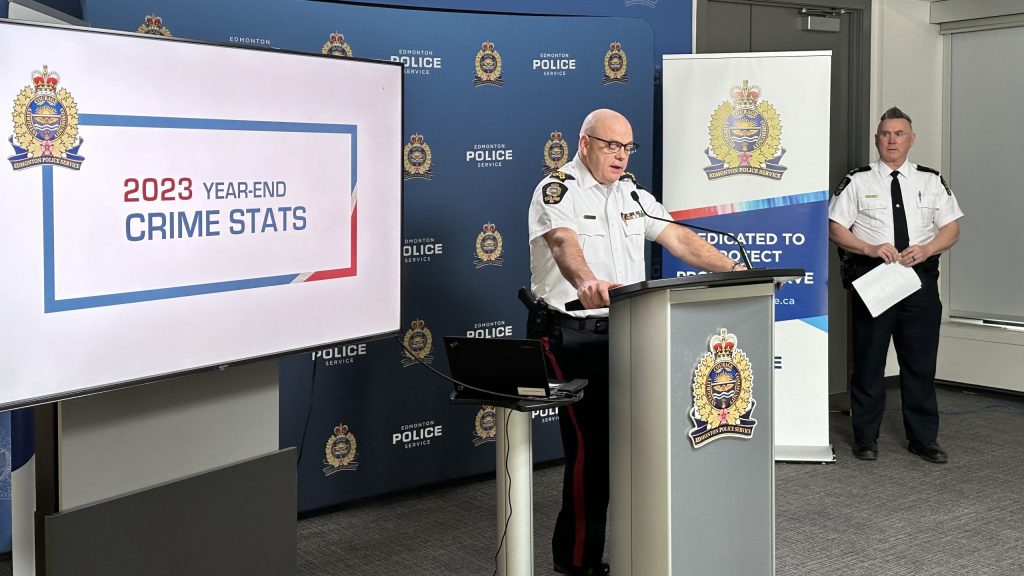‘Atmosphere of terror’: Fires in southeast Edmonton may be gang-linked extortion, displays of power, expert says
Posted January 3, 2024 1:14 pm.
Last Updated January 3, 2024 1:24 pm.
Since the beginning of November, residents in the community of Aster in southeast Edmonton have woken up to fire after fire, destroying newly built homes from top to bottom.
Multiple residents living in the area have told CityNews they are concerned by what they call suspicious blazes, and they fear for their safety. Many believe the fires are related to gang retaliation and organized crime.
BACKGROUND: Residents concerned for their safety after fire destroys another southeast Edmonton home
Robert Gordon, a professor emeritus at Simon Fraser University, says arson is a “common weapon” used by organized crime groups to intimidate individuals and groups.
“It’s all part of the extortion process,” said Gordon, with the university’s International CyberCrime Research Centre. “And if we are talking about drugs and the drugs industry, then most certainly this is an extortion weapon along with other shootings.”
Gordon says organized crime groups have been going after vacant, newly built and under-construction homes as part of international extortion activities.
“I wouldn’t be at all surprised if there aren’t connections to a larger extortion picture, but the police aren’t going to be forthcoming with this information yet because these are active investigations,” he said.
Connected to extortion in India?
What appears to be happening in Edmonton, according to Gordon, is “very similar to the extortion activities that have been going on amongst groups that are operating out of Punjab (India).”
“I’m quite confident that the police will be, if not already, well on the way to identifying the suspects and dealing with the issue,” Gordon told CityNews Tuesday. “Most certainly, this is connected to groups operating or based in Punjab, then they’re already well ahead of the game because the police in India and the Punjab people in particular are well aware of what’s going on, and they’re talking to police in Canada and also in Oregon, interestingly enough, but there is activity taking place down there.
“There is a spread here that covers elements of the South Asian community in North America.”
According to Gordon, business owners are often targeted and individuals offer “protection” in exchange for cash.
“The idea is to create an atmosphere of terror, and through that atmosphere of terror, extract cooperation from individuals who might not otherwise be cooperative,” Gordon explained. “But there could be any number of reasons why they’re doing it. Really it’s to maintain power and control in the particular industry or market place depending on what it is they’re doing.”
RELATED: EFRS deals with pair of overnight fires
Gordon says since the beginning of the year there have been “alarming developments” when it comes to organized crime across Canada.
“In the last 48 hours there have been a lot of things happening across the country and extortion, with regards to these types of investigations.”

Targets of extortion: high profile, wealthy people
Gordon believes a “common and popular” move in the playbook of organized criminals is “terrorizing these individuals by providing examples of what can happen.”
“Setting fires is a pretty good example of how you could terrorize somebody because you can physically demonstrate your ability to be able to destroy something that’s of value,” he said.
The SFU professor emeritus describes extortion victims as “high profile and wealthy individuals.”
“They are approached in a number of ways, usually by individuals face to face, and advised they need to be seriously considering ‘security service,’ because their businesses are at risk. And so they will set up a mechanism for payment, and usually that’s enough, but it depends on who they are in the community,” Gordon said.
“People are terrified, yes, by what’s going on, and if there is a way of protecting themselves, they’re going to be compliant. So that’s what these particular groups and individuals want to have happen.”
—Robert Gordon, professor emeritus at Simon Fraser University
Gordon describes the groups involved in this type of extortion as “divided along ethnic lines.”
“Brothers Keepers, Hells Angels, these are essentially Canadian-based groups although they do operate extensively in Anglo-Saxon communities in North America generally,” he said. “They tend to be multi-ethnic and that brings them into connections with the drug trade in the Fraser Valley in B.C., and that brings them in with the United Nations group in the Fraser Valley in B.C. that is very active and is not something that we should consider lightly.”
Drug activity in small towns north of Edmonton
The groups are “very busy” in the energy sector in the northeast of Alberta, according to Gordon.
“So up in Grande Prairie and places like that, Dawson Creek, which are seemingly unimportant, small towns, there’s a fair bit of energy pulled into the drug trade in those locations because the markets are up there. So you’ve got a lot of energy sector workers, young, and bored beyond belief who are buying and trading the drugs. So that’s why there is a lot of activity there north of Edmonton.
“It’s a belt going across the northern part of Canada and everything north of that belt, the economy seems to be energy-driven and that energy sector attracts a huge amount of money and a lot of services and resources are offered to that community that has the assets to be able to buy drugs for example. And it’s actually always been a long-standing link between the organized crime groups operating in location in the southern portion of Alberta and B.C. and the markets in the north portions. Very, very lucrative, which is what’s driving it, there’s no question about that.
“I know there has been one individual in B.C. who has been picked up. This is to do with business extortion generally.”
Extortion task force in Ontario
A seemingly similar situation targeting the same groups of people may be occurring in Ontario.
On Dec. 9, Ontario’s Peel Regional Police arrested Tanmanjot Gill, a 23-year-old man from Abbotsford, B.C., for allegedly discharging a gun and firing multiple rounds at a business in Brampton.
On Dec. 22, police in Peel announced they were investigating a “disturbing trend of extortion attempts.”
In a news release issued by the police force, they say “these attempts are primarily targeted towards members of our South Asian business community. Victims are contacted through a variety of social media platforms and demands for money are made under threats of violence, which have occurred in some incidents. Nine incidents are currently being investigated.”
Peel police launched an Extortion Investigative Task Force (EITF) — a dedicated team of investigative and intelligence units supported by tactical teams.
“The EITF will continue to work with community members and other law-enforcement agencies on the investigations,” the force wrote in a statement.
Possible gang retaliation
In a year-end interview, Edmonton police Chief Dale McFee told CityNews the city added another gang suppression unit following the deadly shooting of Harpreet Uppal and his 11-year-old son Gavin, which sources have said was linked to the ongoing gang wars between Brothers Keepers and the United Nations gang.
RELATED: Killing of father, son could have ripple effect of trauma on children and community: psychotherapist
McFee says the city is doing whatever they can to prevent retaliation.
“The only way to do that is through the appropriate enforcement and communication, so that’s something we continue to work with,” McFee said. “It’s not just an Edmonton thing. This goes through other cities as well, and we need to make sure we obviously try to prevent it from happening, and if it ever does happen, we obviously have to be on it and try and solve it as quickly as we can.”
WATCH: Police chief addresses targeted shooting
“These are very sophisticated organizations that are way beyond the borders of Edmonton, yes, and that’s why it takes multiple jurisdictions and that’s why we work on these things and intelligence in relation to this. There’s very little organized crime that I’ve ever seen that’s just in one area. That’s how you expand your territory, through intimidation, violence and obviously it’s about the commodity, which is the cash.”
‘A demonstration of what we were able to do’
Gordon says there is always a bit of “a public risk,” but adds if police respond swiftly, it creates an atmosphere of trust. He says police across Canada, India and Oregon are “going to be busy connecting the dots this week.”
“If they’re burning unoccupied, partially completed homes, then you’ve got a big loss, from the point of view of the victim, and a lower risk from the point of view of the offender, because there is no damage to human beings,” said Gordon. “And so the enthusiasm for doing it or preventing it is reduced significantly. But it’s really trying to create an atmosphere of terror. Then they go back to the source of the money and say, ‘look, we’ve just given you a demonstration of what we were able to do, here are the terms and conditions.’
“It really is a technique that used to be used by the mafia and now these groups are borrowing what is in fact a very effective way of squeezing people for money. The limit lies in the fact that at any moment, as money is passed from hand to hand, there can be an investigation and a trap is sprung and then you’re gone. So sometimes I think some of the transfer does appear electronically, but I do believe most of the work that is being done, most of the cash is being transferred physically because it’s easier to do that and it’s low risk, leaving no trace.”

Gordon says what’s often hampering police is the resources available, and the information they need to go ahead comes from victims.
“It has to be taken seriously and generally is taken seriously by police authorities, but they need to respond promptly and effectively to be able to assure people that they’re on the game and they’re on the ball. And if they don’t, it sends the wrong signal to the community, but also to those involved in the criminal activity,” Gordon said.
“So if people are worried about running to the police, until such time that police demonstrate that they are trustworthy and effective and efficient, then when they start making arrests and rounding people up, that paints a very important message.”








